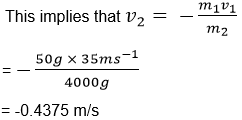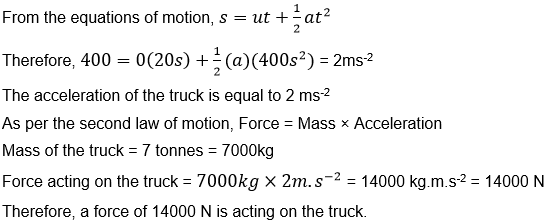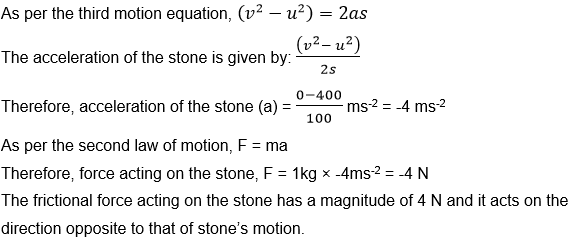1. Which of the following has more inertia: (a) a rubber ball and a stone of the same size? (b) a bicycle and a train? (c) a five-rupee coin and a one-rupee coin?
Solution
Since inertia is dependent on the mass of the object, the object with the greater mass will hold greater inertia. The following objects hold greater inertia because of their mass.
- Stone
- Train
- Five-Rupee coin
2. In the following example, try to identify the number of times the velocity of the ball changes: “A football player kicks a football to another player of his team who kicks the football towards the goal. The goalkeeper of the opposite team collects the football and kicks it towards a player of his own team”. Also identify the agent supplying the force in each case.
Solution
Let the two football teams be team A and team B respectively. Initially, the football is at rest. Now, the football is kicked by a player on team A to another player of team A. (The velocity of the ball has changed 1 time so far). This change is brought on by the force applied by the player who kicked the ball.
The football is now kicked by the other team A player towards the goal. (The velocity of the ball has changed 2 times so far). This change is also brought on due to the force applied by the team A player who kicked the ball.
The goalkeeper of team B stops the ball, bringing it to rest. (the velocity of the ball has changed 3 times so far). This change is brought on by the force applied by the goalkeeper of team B to stop the ball.
Finally, the goalkeeper of team B kicks the ball towards another player of team B. the velocity of the ball changes for a final time, bringing the total count to 4. This change is also brought on by the goalkeeper of team B, who applies the force to kick the ball forward.
Therefore, the velocity of the ball changes 4 times in this example.
3. Explain why some of the leaves may get detached from a tree if we vigorously shake its branch.
Solution
When the branch of the tree is shaken, the branch moves in a to-and-fro motion. However, the inertia of the leaves in attached to the branch resists the motion of the branch. Therefore, the leaves that are weakly attached to the branch fall off due to inertia whereas the leaves that are firmly attached to the branch remain attached.
4. Why do you fall in the forward direction when a moving bus brakes to a stop and fall backwards when it accelerates from rest?
Solution
Initially, when the bus accelerates in a forward direction from a state of rest, the passengers experience a force exerted on them in the backward direction due to their inertia opposing the forward motion.
Once the bus starts moving, the passengers are in a state of motion in the forward direction. When the brakes are applied, the bus moves towards a position of rest. Now, a force in the forward direction is applied on the passengers because their inertia resists the change in the motion of the bus. This causes the passengers to fall forwards when the brakes are applied.
Intext Questions – 2 Page: 126,127
1. If action is always equal to the reaction, explain how a horse can pull a cart.
Solution
When the horse walks in the forward direction (with the cart attached to it), it exerts a force in the backward direction on the Earth. An equal force in the opposite direction (forward direction) is applied on the horse by the Earth. This force moves the horse and the cart forward.
The velocity at which the horse can move by applying a force on the earth depends on the mass of the horse (and the cart attached to it). The heavier the cart, the slower the motion of the horse (for a given amount of force applied by the horse on the Earth). If the cart is too heavy, the force exerted by the horse on the Earth will be insufficient to even overcome the force of inertia. In this case, the horse will not be able to pull the cart.
2. Explain, why is it difficult for a fireman to hold a hose, which ejects large amounts of water at a high velocity.
Solution
For the hose to eject water at high velocities, a force must be applied on the water (which is usually done with the help of a pump or a motor). Now, the water applies an equal and opposite force on the hose. For the fireman to hold this hose, he must apply a force on it to overcome the force applied on the hose by the water. The higher the quantity and velocity of the water coming out of the hose, the greater the force that must be applied by the fireman to hold it steady.
3. From a rifle of mass 4 kg, a bullet of mass 50 g is fired with an initial velocity of 35 m s–1. Calculate the initial recoil velocity of the rifle.
Solution
Given, the Bullet’s mass (m1) = 50 g
The rifle’s mass (m2) = 4kg = 4000g
Initial velocity of the fired bullet (v1) = 35 m/s
Let the recoil velocity be v2.
Since the rifle was initially at rest, the initial momentum of the rifle = 0
Total momentum of the rifle and bullet after firing = m1v1 + m2v2

As per the law of conservation of momentum, the total momentum of the rifle and the bullet after firing = 0 (same as initial momentum)
Therefore, m1v1 + m2v2 = 0
4. Two objects of masses 100 g and 200 g are moving along the same line and direction with velocities of 2 ms–1 and 1 ms–1, respectively. They collide and after the collision, the first object moves at a velocity of 1.67 ms–1. Determine the velocity of the second object.
Solution
Assuming that the first object is object A and the second one is object B, it is given that:
Mass of A (m1) = 100g
Mass of B (m2) = 200g
Initial velocity of A (u1) = 2 m/s
Initial velocity of B (u2) = 1 m/s
Final velocity of A (v1) = 1.67 m/s
Final velocity of B (v2) =?
Total initial momentum = Initial momentum of A + initial momentum of B
= m1u1 + m2u2
= (100g) × (2m/s) + (200g) × (1m/s) = 400 g.m.sec-1
As per the law of conservation of momentum, the total momentum before collision must be equal to the total momentum post collision.

v2 = 1.165 m/s
Therefore, the velocity of object B after the collision is 1.165 meters per second.
Exercises Page: 128,129
1. An object experiences a net zero external unbalanced force. Is it possible for the object to be travelling with a non-zero velocity? If yes, state the conditions that must be placed on the magnitude and direction of the velocity. If no, provide a reason.
Solution
Yes, it is possible. An object moving in some direction with constant velocity will continue in its state of motion as long as there are no external unbalanced forces acting on it. In order to change the motion of the object, some external unbalanced force must act upon it.
2. When a carpet is beaten with a stick, dust comes out of it. Explain.
Solution
When the carpet is beaten with a stick, the stick exerts a force on the carpet which sets it in motion. The inertia of the dust particles residing on the carpet resists the change in the motion of the carpet. Therefore, the forward motion of the carpet exerts a backward force on the dust particles, setting them in motion in the opposite direction. This is why the dust comes out of the carpet when beaten.
3. Why is it advised to tie any luggage kept on the roof of a bus with a rope?
Solution
When some luggage is placed on the roof of a bus which is initially at rest, the acceleration of the bus in the forward direction will exert a force (in the backward direction) on the luggage. In a similar manner, when a bus which is initially in a state of motion suddenly comes to rest due to the application of brakes, a force (in the forward direction) is exerted on the luggage.
Depending on the mass of the luggage and the magnitude of the force, the luggage may fall off the bus due to inertia. Tying up the luggage will secure its position and prevent it from falling off the bus.
4. A batsman hits a cricket ball which then rolls on a level ground. After covering a short distance, the ball comes to rest. The ball slows to a stop because (a) the batsman did not hit the ball hard enough. (b) velocity is proportional to the force exerted on the ball. (c) there is a force on the ball opposing the motion. (d) there is no unbalanced force on the ball, so the ball would want to come to rest.
Solution
When the ball rolls on the flat surface of the ground, its motion is opposed by the force of friction (the friction arises between the ground and the ball). This frictional force eventually stops the ball. Therefore, the correct answer is (c).
If the surface of the level ground is lubricated (with oil or some other lubricant), the friction that arises between the ball and the ground will reduce, which will enable the ball to roll for a longer distance.
5. A truck starts from rest and rolls down a hill with a constant acceleration. It travels a distance of 400 m in 20 s. Find its acceleration. Find the force acting on it if it’s mass is 7 tonnes (Hint: 1 tonne = 1000 kg.)
Solution
Given, distance covered by the truck (s) = 400 meters
Time taken to cover the distance (t) = 20 seconds
Initial velocity of the truck (u) = 0 (since it starts from a state of rest)

6. A stone of 1 kg is thrown with a velocity of 20 ms-1 across the frozen surface of a lake and comes to rest after travelling a distance of 50 m. What is the force of friction between the stone and the ice?
Solution
Given, Mass of the stone (m) = 1kg
Initial velocity (u) = 20m/s
Terminal velocity (v) = 0 m/s (the stone reaches a position of rest)
Distance traveled by the stone (s) = 50 m

7. An 8000 kg engine pulls a train of 5 wagons, each of 2000 kg, along a horizontal track. If the engine exerts a force of 40000 N and the track offers a friction force of 5000 N, then calculate: (a) the net accelerating force and (b) the acceleration of the train
Solution
(a) Given, force exerted by the train (F) = 40,000 N
Force of friction = -5000 N (the negative sign indicates that the force is applied in the opposite direction)
Therefore, the net accelerating force = sum of all forces = 40,000 N + (-5000 N) = 35,000 N
(b) Total mass of the train = mass of engine + mass of each wagon = 8000kg + 5 × 2000kg
The total mass of the train is 18000 kg.
As per the second law of motion, F = ma (or: a = F/m)
Therefore, acceleration of the train = (net accelerating force) / (total mass of the train)
= 35,000/18,000 = 1.94 ms-2
The acceleration of the train is 1.94 m.s-2.
8. An automobile vehicle has a mass of 1500 kg. What must be the force between the vehicle and road if the vehicle is to be stopped with a negative acceleration of 1.7 ms-2?
Solution
Given, mass of the vehicle (m) = 1500 kg
Acceleration (a) = -1.7 ms-2
As per the second law of motion, F = ma
F = 1500kg × (-1.7 ms-2) = -2550 N
Therefore, a force of 2550 N must act on the vehicle in a direction opposite to that of its motion.
9. What is the momentum of an object of mass m, moving with a velocity v?
(a) (mv)2 (b) mv2 (c) ½ mv2 (d) mv
Solution
Since momentum is defined as the product of mass and velocity, the correct answer is (d), mv.
10. Using a horizontal force of 200 N, we intend to move a wooden cabinet across a floor at a constant velocity. What is the friction force that will be exerted on the cabinet?
Solution
Since the velocity of the cabinet is constant, its acceleration must be zero. Therefore, the effective force acting on it is also zero. This implies that the magnitude of opposing frictional force is equal to the force exerted on the cabinet, which is 200 N. Therefore, the total friction force is -200 N.
11. Two objects, each of mass 1.5 kg, are moving in the same straight line but in opposite directions. The velocity of each object is 2.5 ms-1 before the collision during which they stick together. What will be the velocity of the combined object after collision?
Solution
Given, mass of the objects (m1 and m2) = 1.5kg
Initial velocity of the first object (u1) = 2.5 m/s
Initial velocity of the second object which is moving in the opposite direction (u2) = -2.5 m/s
When the two masses stick together, the resulting object has a mass of 3 kg (m1 + m2)
Velocity of the resulting object (v) =?
As per the law of conservation of momentum, the total momentum before the collision is equal to the total momentum after the collision.
Total momentum before the collision = m1u1 + m2u2
= (1.5kg) (2.5 m/s) + (1.5 kg) (-2.5 m/s) = 0
Therefore, total momentum after collision = (m1+m2) v = (3kg) v = 0
Therefore v = 0
This implies that the object formed after the collision has a velocity of 0 meters per second.
12. According to the third law of motion when we push on an object, the object pushes back on us with an equal and opposite force. If the object is a massive truck parked along the roadside, it will probably not move. A student justifies this by answering that the two opposite and equal forces cancel each other. Comment on this logic and explain why the truck does not move.
Solution
Since the truck has a very high mass, the static friction between the road and the truck is high. When pushing the truck with a small force, the frictional force cancels out the applied force and the truck does not move. This implies that the two forces are equal in magnitude but opposite in direction (since the person pushing the truck is not displaced when the truck doesn’t move). Therefore, the student’s logic is correct.
13. A hockey ball of mass 200 g travelling at 10 ms–1 is struck by a hockey stick so as to return it along its original path with a velocity at 5 ms–1. Calculate the magnitude of change of momentum occurred in the motion of the hockey ball by the force applied by the hockey stick.
Solution
Given, mass of the ball (m) = 200g
Initial velocity of the ball (u) = 10 m/s
Final velocity of the ball (v) = 5m/s
Initial momentum of the ball = mu = 200g × 10 ms-1 = 2000 g.m.s-1
Final momentum of the ball = mv = 200g × 5 ms-1 = 1000 g.m.s-1
Therefore, the change in momentum (mv – mu) = 1000 g.m.s-1 – 2000 g.m.s-1 = -1000 g.m.s-1
This implies that the momentum of the ball reduces by 1000 g.m.s-1 after being struck by the hockey stick.


